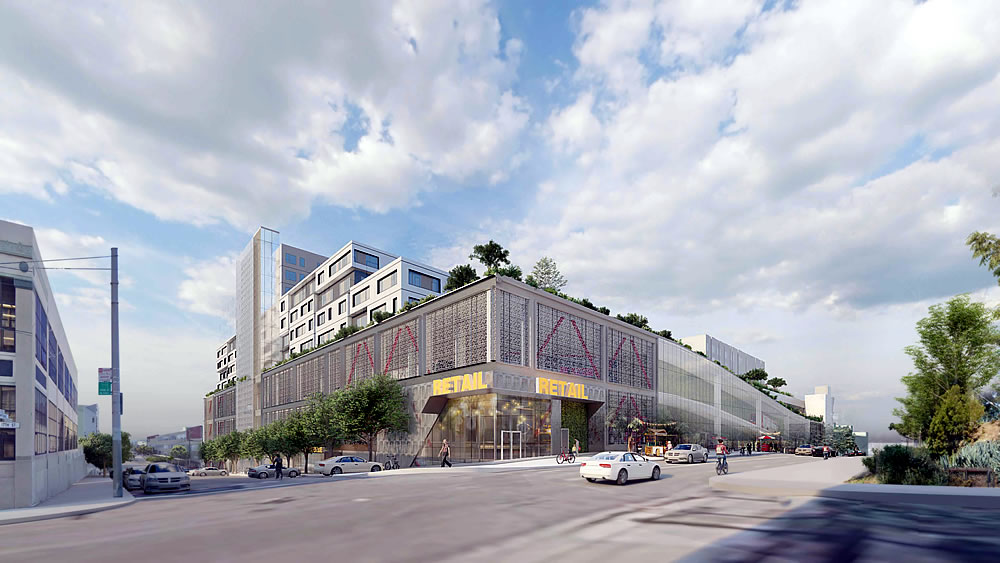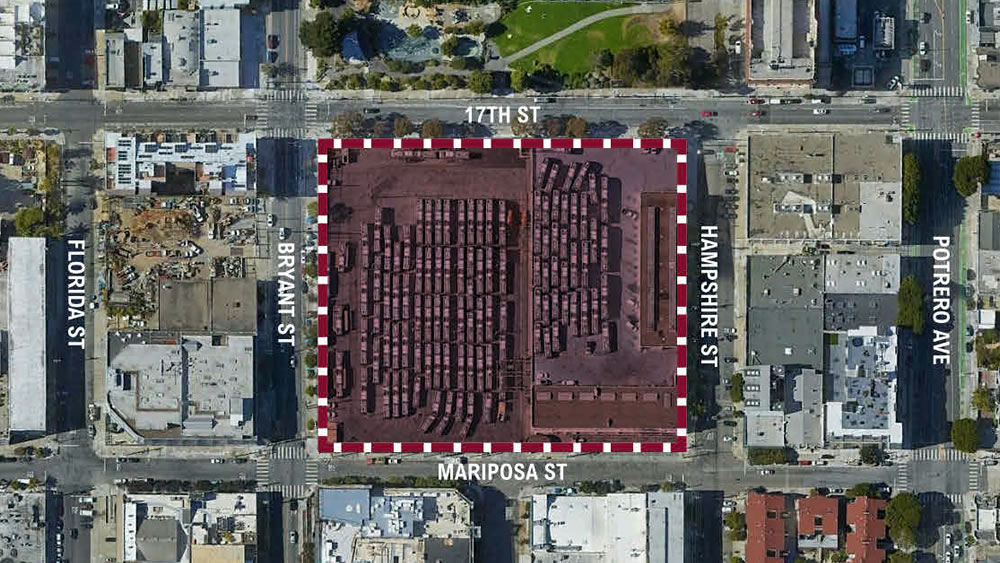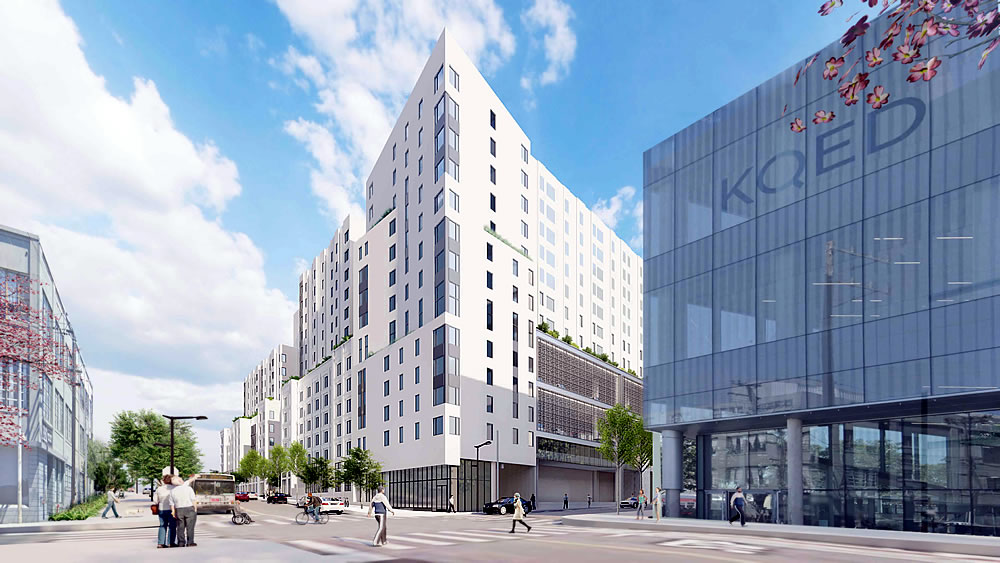A formal application to entitle the San Francisco Municipal Transportation Agency’s ambitious redevelopment of the Potrero Yard Muni Bus Maintenance Facility at 2500 Mariposa Street has been submitted to the City for review.
As refined by the IBI Group for the SFMTA, the redevelopment of the 4.4-acre site would yield a 150-foot-tall mixed-use building along Bryant, with 513 below market rate (BMR) apartments, a mix of 119 studios, 183 one-bedrooms, 142 twos and 68 threes; a three-story bus garage designed to facilitate Muni’s transition to an all-electric fleet fronting Mariposa; and 3,200 square feet of commercial space on the corners of Bryant, Mariposa and 17th.
And once again, while the Mariposa Street site is currently only zoned for Public uses and limited to development up to 65 feet in height, a legislatively-driven Special Use District (SUP) to enable the now proposed $700 million redevelopment is in the works with Planning’s support.



EPIC BLAND
How much of MUNI is currently non-electric? There don’t seem to be too many bus lines that are running on diesel.
Offhand I know that when the 5 and 5R commingle, the 5s becom diesel-hybrid so the 5Rs trollybuses can jump ahead of them as needed. None of the 38 Geary variants are electrified, and that’s one of the network’s busiest lines. 8 San Bruno uses 101 for a stretch.
It’s murky. Last thing I personally read about that topic, their 2018 blog post, San Francisco Commits To All-Electric Bus Fleet By 2035, all the way down at the 10th ‘graph:
Emphasis added.
So what you seem to be asking about is what lines are currently running solely diesel busses. I wouldn’t give them the benefit of the doubt with regards to “renewable diesel”, in my mind diesel of any kind doesn’t move the needle. I don’t know, and they appear to have pretty a good PR firm advising MUNI not to talk too much about that stat. I would suspect that the number of pure electric busses is less than it would appear as of that post.
Obviously, things could have improved as far as pure electric vis a vis hybrid vehicles over the last half-decade. I have no reason to doubt that “the SFMTA operates the greenest transit system of any major city in North America”.
Muni operates about 1,200 vehicles: 550 diesel-electric hybrid buses, 300 electric trolleybuses, 250 modern light rail vehicles, 50 historic streetcars and 40 cable cars…
Sounds like about half, at least measured by vehicles. How often they operate in diesel mode isn’t clear.
I think that, like hybrid cars, those hybrid buses are using diesel fuel a lot of the time, like when they accelerate or drive faster than maybe 20 mph or so. Their power is a combination of diesel and electric most of the time. So they will get significantly better gas mileage than a purely diesel bus, but they probably don’t have an “electric mode” that allows them to drive for any length of time without using the diesel engine. I don’t think they have sufficient battery storage to run exclusively from battery power for any length of time.
If I’m wrong about that I imagine someone will correct me.
except when the busses enter woke mode for short periods of time…
Thanks for sharing that link. When Muni switches over to fully battery electric bus models such as the Proterra ZX5 currently in use on route 57 Parkmerced, identifying such zones where hybrid busses will or should not produce diesel emissions will become moot because there won’t be any diesel fuel being burned.
Amazing, build it!
Does anyone know what Muni plans to do with the other nearby bus depot for gas buses, at 15th & Folsom? 17th & Bryant can handle all the electric buses, and they’re phasing out the gas buses, then it would seem they don’t need 15th & Folsom anymore.
The hybrid Diesel buses at nearby Flynn one would think transition to all-electric buses over time.
The already-electric trolley buses remain at Bryant, continuing to use the existing overhead infrastructure to get to and from. No fundamental changes from an operational POV it seems.
The big irony living atop a bus yard might be that pull-outs do not pick up on the deadheads from the yard to which ever route the trolley is headed for – “NOT IN SERVICE”. So you find yourself hoofing over to 16th St. regardless and on the way back you’re getting kicked out on 16th St.
In that case they forgot the catenary wires in the rendering 🙂 But seriously, I thought we were getting rid of trackless trolleys, eventually, in favor of batteries?
Trolleys are attractive for routes that involve a lot of climbing – no need for lifting Diesel fuel or battery packs up the hill. And that’s assuming a regular Diesel or electric bus packed with riders can get up the incline in the first place.
Like the 3 bedroom unit count but basically looks like a value engineered monstrosity with Mariposa looking ominous & without better materials will look run down shortly after opening day. At least Improve materials & meet the street is a more welcoming way. That podium with apartments with apartments above could also be liberated.
Based on the description (top) I believe that’s the “muni bus garage” portion…so it’s probably pretty limited as to what they can do with it.
This is a winning strategy that pretty much every public transportation system in the US is going to try to use, especially given the scary budget situation due to work from home. Every station and parking lot should be developed.
I’m all for this project, but that image with the KQED building is a joke. The angle magically makes the 150 foot tall building look similar to the 3ish story one.
The KQED building is hardly “3ish story” – its floor heights are more than double the norm; a quick check of Google street view will show that it’s more than 2x the height of an old industrial building on the other side of Bryant, and at least 3 times the height of the Muni bus wires (which, per a quick Google search, are +/- 17.6 feet above the street) – either way, well over 50′ in height.
I have no idea how a project like this would pencil, or what kind of legitimate financial institution would actually put up the funds to back a boondoggle like this. Then there is the matter of the SFMTA’s track record. That agency can’t even roll out a new bike lane on Valencia Street without it being a poorly designed disaster!
I doubt this project will ever get anywhere close to reality. If by some miracle it does get built it will probably be riddled with so many design flaws and “value engineering” compromises as to make it a horribly unpleasant and unmarketable as a residential building, and a needlessly inefficient and hamstrung bus yard..
The Valencia St. bike lane is so poorly done, they forgot(?) to leave a passthrough to get into the police station, so cop cars are tiptoeing over the bump stops across the bike lane.
This colossus is a monstrosity. I’ve seen prisons with more curb appeal. If it looks this bad in the renderings, think how bad it will look in real life. How did MTA choose the architects? Contrast this pathetic effort with the two major subsidized projects (334 units) slated for Transbay Block 2.